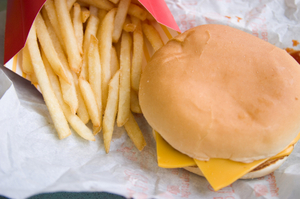The overweight person is often accused of being lazy, lacking in willpower and constantly overeating. While choice of food, the amount eaten and exercise do affect weight, researchers now feel that there may be another component. (And I’m not referring to genetics.)
The previously ignored element may be food addiction. It doesn’t necessarily mean that we’re desperate enough to hold up the Piggly Wiggly for a candy bar, (though I have been almost that desperate at times for chocolate.) According to Dr. Neal D. Barnard, in his book, Breaking The Food Seduction, a University of Michigan research team found that chocolate stimulates the same part of the brain that opiate drugs do. In other words, chocolate acts like a drug (producing a food addiction), that causes us to crave more and more of it. Before we know it, we’re on our way to being chocolate addicts. (Hmm…I wonder if there is a 12-step program for that?) But as you will see, food addiction is no laughing matter. Chocolate also contains other stimulant drugs, such as caffeine, theobromine, and phenylethylamine (an amphetamine-like compound.) According to Dr. Barnard, “Chocolate isn’t really a drug–it’s the whole drug store wrapped up in one.
But chocolate’s not the only food addiction. Dr. Bernard, president of the Physicians Committee for Responsible Medicine, found through research studies, that when people were taken off of meat and dairy products, the yearning for cheese was described as a “deep seated craving” that stayed with them much longer than their compulsion for other foods. Eli Hazum and his associates at Wellcome Research Laboratories, in Research Triangle Park, NC, found a chemical in cow’s milk similar to morphine. After testing it repeatedly, they discovered that it was, in fact, morphine. It was only a trace amount, and not all the samples contained the chemical in recognizable levels, but there was indeed a small amount of morphine in cows milk. Assuming that the morphine must have come from the cows’ diets, they were shocked to find that the cows actually made traces of it within their bodies, along with codeine and other opiates, that were produced in their livers. They also were surprised to learn that cow’s milk (and the milk of any species) contains the protein, casein, that breaks down during the digestion process, and releases other opiate-like compounds called casomorphins. (Please don’t mug the milkman in the morning.) What does this have to with cheese? Casein is concentrated in cheese. (So we have the makings of another possible food addiction.)
Why are there traces of morphine in milk? (Actually, it’s not some environmental problem.) Scientists believe that the mother’s milk has a relaxing effect on the baby, and this drug-like affect on the brain is responsible for the bonding that is necessary, for the baby to get the nutrition he needs. (Isn’t nature marvelous?) Researchers gave volunteers yogurt and skim milk, and found that the casein (milk opiates) not only acted within the digestive tract, but some of the fragments actually entered the bloodstream, with direct access to the brain. The effect was greatest about 40 minutes after eating. As mentioned before, cheese has more casein than other dairy products. (Recent studies have found that meat also stimulates the brain’s pleasure centers.) To further prove their theory, researchers found that when volunteers were given naloxone, (a drug that blocks opiates, used in the treatment of heroin and morphine overdoses), their desire for cheese, meat, chocolate, and other addictive foods was greatly decreased.
In addition, scientists have discovered that fast foods, like hamburgers and fries, may also be responsible for food addictions. The high fat and carbohydrate content causes changes in the brain, that are normally correlated with drug addiction, (and the result is food addiction.) That’s right, according to John Hoebel, a psychologist at Princeton University, sugar and fat stimulates the release of natural opiates in the brain, and may be triggering the same response as heroin. (Please put down the sugar bowl, and that Big Mac.) After giving rats a diet that was one quarter sugar, he abruptly withdrew the sugar, and the rats went into high anxiety mode, experiencing trembling and teeth chattering, similar to the effects that occur during morphine or nicotine withdrawal. So, in review, the sugar produced the same withdrawal effects that highly addictive drugs do. (This is very compelling information when studying food addiction.)
Food addiction plays an enormous role in our eating habits, when we’re depressed, tired, lonely, anxious, worried, fearful, etc. We run to the addictive food of choice. (For me, it is chocolate and sugar, with carbohydrates following close behind, which is particularly bad, because I am a diabetic.) Certain foods act as drugs, because our body responds to the natural opiates in them, just as it would to drug opiates. As we experience these effects over and over, we may develop a food addiction.
Medical scans have even been able to document these findings about food addiction. Researchers compared the brain scans of drug addicts with chronic over-eaters, and found startling similarities. If you think about it, many of the behaviors are the same–the obsession, compulsion, and preoccupation with drugs, is often also experienced with food. The overwhelming guilt, the tendency to use drugs to relieve emotional problems, and even the secrecy that is often involved in drug use, is also a part of compulsive overeating. While none of the researchers are suggesting that the physical and emotional drive is as strong with food, as it is with heroin, what they have found, is that some of the previously mentioned food addictions, are a part of the overall problem of obesity or overeating. Food addiction is real, according to scientific research.
So how do we kick the habit of food addiction? (Unlike coming off of drugs, we can’t just stop eating.) Dr. Barnard suggests starting your day with a good breakfast, that will help you keep food cravings at a minimum. Try to keep blood sugar levels normal by staying away from white sugar, white flour, white bread, and other starchy foods such as white potatoes, rice, and pasta. Instead substitute low-fat protein, vegetables, beans, low-sugar fruits, and whole grains. Eat enough healthy foods to satisfy your hunger, and don’t go on starvation diets. You’ll just end up binging sooner or later, because your body feels so deprived. Take a break from some of the more addictive foods, and you will soon experience less of a craving for them. Food addictions are just one component of overeating, and obesity. There are often metabolic issues, genetic variables, and complex physical and emotional reasons why we overeat. But learning about the addictive nature of some foods, can enable us to understand the powerful cravings that we sometimes experience, and help us on our path to healthy food choices.
Sources: http://www.usatoday.com/news/health/2007-07-09-food-addiction_N.htm
http://www.pcrm.org/magazine/gm03summer/gm03summer02.html
http://video.google.com/videoplay?docid=-3214100593069532942
http://news.bbc.co.uk/2/hi/health/2707143.stm
http://news.bbc.co.uk/2/hi/health/5399762.stm




